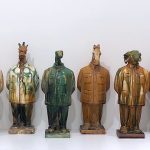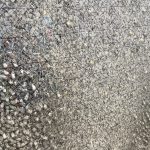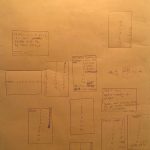BRANDON BALLENGÉE







MIA Spreadfin Skate, 2020
Mixed media with Deepwater Horizon source crude oil; Taylor/MC20 source crude; contaminated marshland sediment with oil; anaerobic bacteria and iron oxide; and COREXIT 9500A (dispersant) on Arches hot press watercolor paper

MIA Highfin Bienny, 2020
Mixed media with Deepwater Horizon source crude oil; Taylor/MC20 source crude; contaminated marshland sediment with oil; anaerobic bacteria and iron oxide; and COREXIT 9500A (dispersant) on Arches hot press watercolor paper

RIP Great Auk: After John James Audubon, 1858/2023
Bien edition chromolithograph
26 x 39 in., unframed

SOS Gulper Eel, 2023
repurposed house paint on thrift bed sheets
56 x 98 in.

RIP Quagga: After Dr. V. Kirn I. Berg, 1844/2023
Hand-colored copperplate engraving
9.25 x 11.5 in., unframed

Apple is more than a tech company; it became a culture unto itself, a passion of most of people and the birthplace of the world’s most revolutionized products.
Madison Ave New York
Brandon Ballengée
L’Art de la Solitude (The Art of Loneliness)
November 10, 2023 – January 27, 2024
L’Art de la Solitude (The Art of Loneliness), Brandon Ballengée’s debut solo exhibition at the gallery, presents a poignant and multifaceted exploration of the interplay between art, biodiversity, and humanity. Showcasing more than three dozen works selected from the 1990s to 2023, the exhibition is a testament to Ballengée’s engagement with the ongoing ecological crisis and the profound ramifications of species loss, prominently coined as the Anthropocene or Sixth Great Extinction. It is an artistic intervention that beckons viewers to confront the realities and consider the urgent need for preservation and conservation. L’Art de la Solitude (The Art of Loneliness) runs from November 10 through December 30, 2023, with the OPENING RECEPTION on Friday, November 10, 6 – 8 PM, accompanied by CENTRAL PARK BIRD WALK on November 11 and THE ARTIST TALK on November 18 at the gallery.
Brandon Ballengée, an artist, biologist, and environmental advocate, utilizes a myriad of mediums and artistic expressions to mirror the current ecological predicament. At the core of this exhibition lie three distinct series, each foraging into the complexities of our environmental challenges:
FRAMES OF ABSENCE
‘Frameworks of Absence,’ initiated in 2006, meticulously embodies the extinct species’ haunting absence. By physically cutting images of vanished animals from historical prints, Ballengée forges what he terms ‘Frameworks of Absence.’ These assemblages not only signify the species lost but also involve a transformative event, where the burned remains of these cut images are gathered in urns, symbolizing a personal and collective remembrance.
THE CRUDE OIL PAINTINGS
The ‘Crude Oil Paintings’ series, which commenced in 2020, immerses itself in the enigma of lost fish species endemic to the Gulf of Mexico post-Deepwater Horizon spill. The artist embarks on an arduous quest to portray these missing creatures, drawing from preserved specimens and utilizing contaminated sediments and dispersants to craft their haunting portraits. This series serves as a contemplative reflection on what is obscured and irretrievably lost due to our collective treatment of the environment.
SOS PAINTINGS
Continuing his artistic journey into the present and beyond, the ‘SOS Paintings’ provide an introspective look into the looming threat of deep-water mining in the Gulf of Mexico. These colossal paintings, created using unconventional materials like thrift bed sheets and latex house paint, are interpretations of deep-sea species at risk due to this emerging deep-sea mining industry. Ballengée captures the mystery and beauty of these enigmatic creatures and ignites contemplation on the potential repercussions of human intervention in this untouched abyssal zone.
L’Art de la Solitude (The Art of Loneliness) is an artistic journey reflecting our ecological plight. Through three compelling series, ‘Frameworks of Absence,’ ‘The Crude Oil Paintings,’ and ‘SOS Paintings,’ Brandon Ballengée epitomizes the essence of loss caused by species extinction and environmental perils. The exhibition’s haunting images of extinct species, the ghostly portrayal of lost Gulf creatures, and the impending threat of deep-sea mining converge. As a catalyst for reflection, the exhibition urges viewers to contemplate the implications of our collective actions on the fragile fabric of our environment. L’Art de la Solitude (The Art of Loneliness) is a visual poetry and a thought-provoking crusade.
REVIEW:
https://www.villagevoice.com/ecology-minded-artist-brandon-ballengee-pictures-what-weve-lost/
WATCH THE VIDEOS
RELATED:
Categories: exhibitions
Tags: Brandon Bellengee
PICASSO, WELCOME TO AMERICA











Madison Ave New York
Picasso, Welcome to America
June 15 – September 27, 2023
R.C. Baker
Brandon Ballengée
Romare Bearden
Deborah Buck
Shijia Chen
Billy Copley
Eileen Foti
Björn Meyer-Ebrecht
Jaye Moon
Pablo Picasso
André Raffray
Janet Taylor Pickett
Zhang Hongtu
Every artist since the early 20th century has been influenced by Pablo Picasso. The protean painter/ sculptor/ printmaker/ ceramicist helped define what “modern” art once was – and is still becoming. In 1939, MoMA’s staff was gathering 300 works by the world’s “most famous living artist” (according to the museum’s press release) for Picasso: Forty Years of His Art. A centerpiece of the exhibit was Guernica, his grisaille mural decrying the destruction of the small Basque town by Nazi bombers, in 1937.
Along with Michelangelo and Rembrandt, the name Picasso (1881-1973) has become a synonym – a cliché, even – for “artist.” But none of the artists in Picasso, Welcome to America see the Spanish-born titan as an old hat. Instead, these ten Americans find in the European trailblazer constant inspiration and ongoing challenge. Zhang Hongtu imagines Chairman Mao exposed by glaring illumination similar to the all-seeing lantern in Guernica. Jaye Moon also reimagines Picasso’s anti-war masterpiece, in When Bob Dylan Meets Picasso, Guernica – using Lego bricks in Braille rather than paint.
The bodies and masks in another Picasso touchstone, Les Demoiselles d’Avignon (1907), come under scrutiny from Eileen Foti and André Raffray through substitution and homage. Billy Copley finds masks in unlikely surroundings, while Janet Taylor Pickett moves effigies aside to place her powerful female figure at center stage. Deborah Buck turns Picasso’s infamously harsh male gaze around, painting surreal figures that might be asking, “Who’s crying now?” In Weary of Treading the Earth, from 1945, Romare Bearden, working in watercolor and ink rather than his later signature collage, energizes cubist space with a circus-like palette. R.C. Baker riffs beyond Picasso’s Blue and Rose periods through primary-colored aluminum printing plates. Björn Meyer-Ebrecht’s dynamic wood and enamel sculpture strips the figure to cubist angles and voids, while Brandon Ballengée searches for animals that, like Picasso’s minotaurs, are no longer with us. Original works by Pablo Picasso will also be on view, commemorating the 50th anniversary of his death.
All of the artists in this exhibition have been influenced by Picasso’s experiments with form and perspective – his breaking of traditional and academic rules. Some of the work here also comments on his darker side, while other pieces engage with the social and political aspects of Picasso’s art. Ultimately, these ten contemporary artists in Picasso, Welcome to America appreciate the formal and aesthetic complexity of a constant innovator. This great artist was effectively barred from ever visiting the United States because he was a member of the French Communist Party. But the joke was on the Feds – Picasso has been in America all along.
VIDEOS
RELATED:

The Brooklyn Rail reviews RC Baker’s solo exhibition, “…and Nixon’s coming” the draft

Jaye Moon is included in the New York Foundation for the Arts exhibition

Janet Taylor Pickett is included in Century: 100 Years of Black Art at MAM

BROOKLYN RAIL reviews Deborah Buck: INTO THE WILD, To Crash Is Divine
Categories: exhibitions
Tags: André Raffray Billy Copley Björn Meyer-Ebrecht Brandon Bellengee Deborah Buck Eileen Foti Janet Taylor Pickett Jaye Moon Kathy Grove Pablo Picasso RC Baker Romare Bearden Zhang Hongtu
JENNIFER CHO: HAYSTACK, MOUNTAINS AND WATERLILIES


Haystack (detail), 2000 - 2023
Compact Discs
Dimension varies

Mountains (detail), 1995 - 2023
Acrylic, colored pencil on canvas
10 x 8 x 1.5 in., each
Dimension varies

Waterlilies (detail), 2000 - 2023
Compact Discs, sepia ink, goldfish, water, vinyl, wood
Dimension varies

Mountains (detail), 1995 - 2023
Acrylic, colored pencil on canvas
10 x 8 x 1.5 in., each
Dimension varies

Waterlilies (detail), 2000 - 2023
Compact Discs, sepia ink, goldfish, water, vinyl, wood
Dimension varies

Haystack (detail), 2000 - 2023
Compact Discs
Dimension varies
Madison Ave New York
Jennifer Cho
Haystack, Mountains and Waterlilies
April 25 – May 31, 2023
In Haystack, Mountains and Waterlilies, Jennifer Cho mobilizes “Slow Art” to articulate the need for sensuous and sensible vigilance within art-making. The exhibition is an ecology of built forms, a simulacra—a made up ecosystem that offers a view of a world proximate to our own. It fuses warm atmosphere with conceptual elegance, drawn from outworn materials. The installations delight and enchant while destabilizing what qualifies as a landscape. In Haystack, Mountains and Waterlilies, all five senses are employed with grace and acerbic wit, balancing consistency with surprise. Cho inhabits the painterly practices of Cezanne, Monet and Millet, transporting their intensely embodied preoccupations with landscape onto her own artistic concerns. Complicated and subtle, the exhibition excavates the sedimentary layers of technology that develop a scene of both intimacy and ignorance; technology we entrust with our most vital choices and secrets.
“Haystack” (2000-2023) is a ghostly, crystalline work carved from soldered compact discs. The term “Slow Tech,” coined by Jennifer Cho, enlists rigid, glittering forms that resemble a natural haystack. Extravagant yet tranquil, the work triggers a human nostalgia for a primordial state of cultivation, as art objects are culled from the natural world. Like Jean-Francois Millet (1814-1875) tributes to the endurance of unrewarded toil for peasants, unspooling the strands of the compact disc requires careful, assiduous work. Taking the time to unfurl these strands, Cho engages in an epic struggle with seemingly slight and minuscule material.
To raise “Mountains” (1995-2023), Jennifer Cho inhabits the practices of Jeong Seon (1676-1759) and Paul Cezanne (1839-1906). While these artists walked through the respective mountains of Mt. Kumgang and Mt. Saint Victoire, they used their footsteps as a way to physically and psychologically register the scene they were about to paint. Cho transposes that footwork into handwork, creating a delicate, melancholy rendering of “Mountains.”
Haunting and menacing, “Waterlilies” (2000-2023) erects shallow pools at the center of a gallery room containing Siamese fighting fish and floating compact discs. Hazy and textured, the clear water grows progressively murky as the fish dart around the pond. The work interlaces narrative with fantasy, developing a false ecosystem from fish and obsolete technology that nonetheless teems with life. The result is an otherworldly biome that seems to exist outside of time and space—an altered reality.
Haystack, Mountains and Waterlilies confers the history of landscape as a long arc, connecting Asian landscape to European plain air works, to Contemporary Art. In these respective works, history provides the framework for new matter, as ostensibly obsolete technology is re-released as mountains, flora, fauna, and water. The exhibition persuades for a fresh conceptualizing of time, asserting a vision of history less as a linear progression but more as a topography whose past is layered within its present material. The beauty of the physical universe is not an illusion of the human eye and the rest of the human sensorium, but a true glimpse into the inner nature of things. Daring to look at works of art in the flesh, Jennifer Cho sees the landscape both in its beauty and in its terror.
VIDEO
RELATED:
Categories: exhibitions
Tags: Jennifer Cho
JANET TAYLOR PICKETT: LIGHT, COLOR AND DESIRE
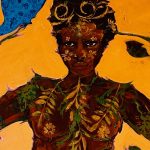









JANET TAYLOR PICKETT: Light, Color and Desire
May 27 – September 3, 2023
Oceanside Museum of Art
Light, Color and Desire presents the art of Janet Taylor Pickett, whose pathbreaking work explores Blackness, identity, and history. A focused solo exhibition of nearly thirty (30) paintings and combines produced between 2003 and 2023, Light, Color and Desire coronates the artist, as a synecdoche for all women, as a contemporary goddess who reigns over fertility, fecundity, and embodied experience. This mythology of Self reaches its apotheosis in Taylor Pickett’s luminous portraiture. Emanating expectancy and resolve, the subjects appear as incarnations of an ongoing desire for social, sexual, and spiritual freedom that is personal and universal. Polemical, unique, politically and socially committed, the art included in Light, Color and Desire demonstrates Taylor Pickett’s arrival at a distinct narrative voice inspired by Johannes Vermeer, Henri Matisse, and Frida Kahlo.
Janet Taylor Pickett was born in Ann Arbor, Michigan in 1948, the third generation in her maternal family to be raised in that city, which was a stop on the Underground Railroad. Her father, Dempsey Taylor Jr., was born in Brownsville, Tennessee and travelled north during the Great Migration, settling with his family in Ypslanti, Michigan. This imbrication of personal and shared Black History is concealed in Taylor Pickett’s work, which pours forth from an arduous path sowed with the sorrow of memories and a sea of desires. In particular, Janet Taylor Pickett’s becoming was influenced by Romare Bearden, whose collaged elements became the bedrock of her own work, situating her as a celebrated collagist.
LIGHT
Janet Taylor Pickett has always been intrigued by light, a preoccupation that she shares with Johannes Vermeer (1632 – 1675). Vermeer implemented camera obscura and applied layers of shadow to achieve the effect of an illuminated subject emerging from the darkness. Taylor Pickett begins with a full composition and then engages color blocking, leaving light to illumine her central subject. Neither plaintive nor condemning, the subjects seem to gaze both inwards and outwards, beholding internal and external topographies with poise and depth. In The Artist Unmasked (2021), the steadfast female gaze belies colossal emotions that the subject restrains. The expression harbors a universal vulnerability; an imperative grace under pressure that a (white) culture expects Black women to retain. This self-possession within constriction also figures in the painting Ladies in Waiting (1981), where the artist is framed by luscious, magenta walls. The light-infused domestic interior pulses with a celestial buoyancy, as though the space hums with ethereal hymns.
COLOR
Light, Color and Desire positions Janet Taylor Pickett as a colorist: an artist keen to the affordances of each hue, and how they inter-animate each other. Taylor Pickett forgoes neutral tones in favor of a kaleidoscopic color scheme, which conjures mood, light and space. Her saturated palette and enlistment of cutouts highlights her dialogue with Henri Matisse (1869 -1954). In The Ritual (2003), an amalgamation of painted and collaged elements, Taylor Pickett recruits cutout dress forms, which augment and amplify Matisse Cutouts. The work curates an altar that colligates a European reference (a painting by Fra Angelico) to African ones: hennaed hands and a fertility figure ringed with a golden aureole. Its display of talismanic forms and Christian iconography renders the work an homage to Black faith and a votive in its own right. Taylor Pickett’s Indigo Blue further highlights her visual dialogue with Matisse (Prussian) Blue. This deep affinity for Blue is enacted in Memory of Water II (2021), which substantiates the ever-present call and response water has had in the collective history of African Americans. Water symbolizes the flow of memory from the Nile, to the Mississippi River to the Middle Passage across the Atlantic Ocean; it is the genetic rhythm of memory that water holds.
DESIRE
Engulfed in flora and fauna, ripe with bold self-possession, the intensely embodied subjects in Janet Taylor Pickett’s work suggest her spiritual linkage to Frida Kahlo (1907-1954), who deployed self-portraiture to explore sexuality, femininity, and her relationship to the natural world. In Forest Born (2022), the roots and curls of flora render an organic issuance from nature. Both artists share an autobiographical narrative that weaves pain and joy to desire. In their political commitments and their unapologetic examination of suffering as well as beauty, they are thematically and aesthetically connected across time and space. Taylor Pickett and Frida Kahlo turn to their own bodies as a site and source of inspiration. While Frida Kahlo lingers on trauma, Taylor Pickett, attuned to life’s difficulties, tributes the beauty of the world and the joy of life. This resiliency and jubilance is personified in the recent painting series Gaia (2022), the goddess of the earth, whose gaze is defiant and searching. The portraits enact the apotheosis of self-actualization; the artist-as-subject is endowed with full agency, and regards the viewer with a gaze that harbors the command of a mystic. As a conceptual linchpin of the exhibition, Gaia confers that Light, Color and Desire is seeing the life of Janet Taylor Pickett.
Janet Taylor Pickett is utterly authentic in her vision and scope: an expression of a life being led in pursuit of psychical, spiritual and aesthetic liberation. It marks her as a vessel for femininity writ large—a contemporary goddess whose beauty and power supercharges life itself. While Taylor Pickett approaches the present as a benediction, she also presides over the past. History suffuses her art. As sustained visual poems, the paintings and combines in Light, Color and Desire probe a personal and collective past to posit a distinctly Black mythology of Self. Taylor Pickett’s work is a serious intellectual interrogation of beauty, nature and emotions that enables her recognition at the fore of Contemporary Art. Imbued with the mysticism of devotional work and the enigmatic lyricism of folklore, Janet Taylor Pickett paints as she emotes.
Dr. Jennifer Baahng, Guest Curator
Related:

Janet Taylor Pickett is included in Century: 100 Years of Black Art at MAM
Categories: exhibitions
Tags: Janet Taylor Pickett
JANET TAYLOR PICKETT: NECESSARY MEMORIES

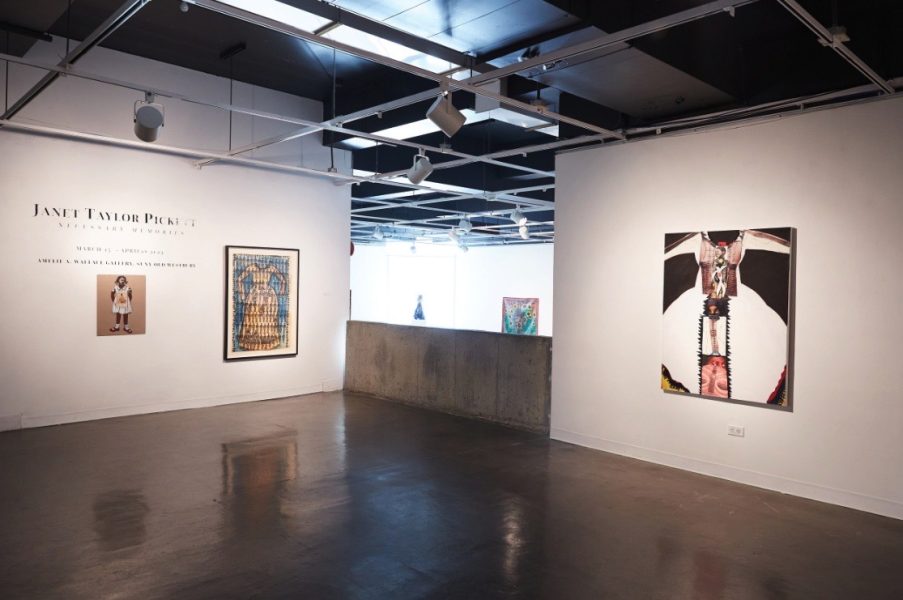
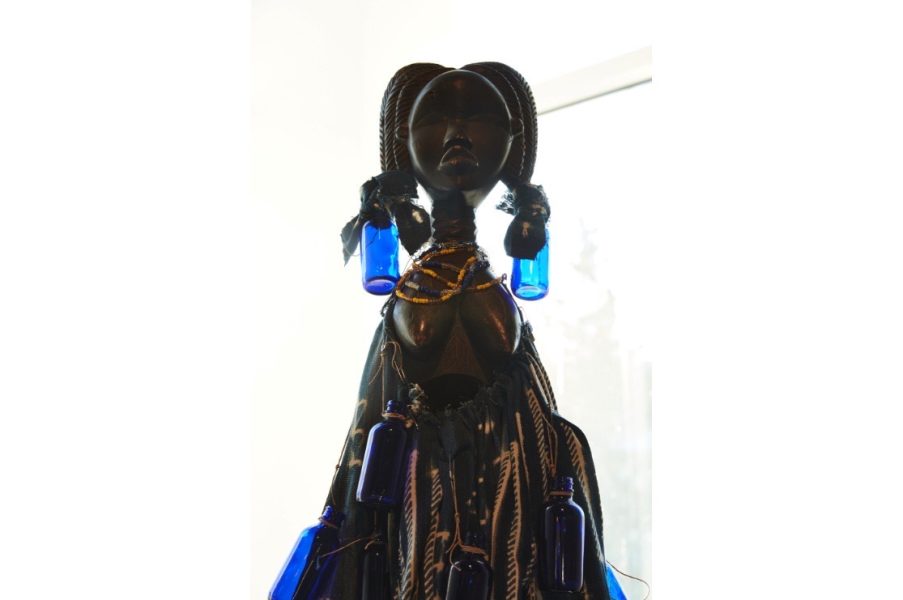








JANET TAYLOR PICKETT: NECESSARY MEMORIES
March 15–April 28, 2023
Amelie A. Wallace Gallery, SUNY College at Old Westbury
Necessary Memories is a solo exhibition of Janet Taylor Pickett that explores her sustained engagement with identity, heritage, and the complexity of lived experience. The exhibition is presented on the occasion of the inauguration of the Black Studies Center and the Black Studies major at the State University of New York at Old Westbury, an initiative representative of the College’s strong social justice mission and racial diversity. A survey of the artist’s prolific body of work from 1972 to 2021, the exhibition showcases over fifty (50) works that externalize the interior life of Janet Taylor Pickett. Intimate and confessional, Necessary Memories pinpoints moments of tension in competing desires for rootedness and freedom. Replete with visual motifs, Janet Taylor Pickett draws on personal biography as a compass to chart a path towards a broader collective heritage that prompts imaginative sustenance for the present.
Janet Taylor Pickett was born in Ann Arbor, Michigan in 1948, the third generation in her maternal family to be raised in that city, a stop on the Underground Railroad. Her father, Dempsey Taylor, Jr., was born in Brownsville, Tennessee, and traveled north during the Great Migration, settling with his family in Ypsilanti, Michigan. This imbrication of personal and shared Black history, concealed in Taylor Pickett’s birthplace, is central to her work. Attuned to the socio-political affordances of her practice, she wields her art as activism: a cautionary tale about the recalcitrance of historical trauma on both the individual and national psyche. Combining quilted constructions, sculptural works, and storytelling through images and handwritten texts, the artist conjures the past with ease, galvanized by her embrace of frustration and pain, and her reckoning with struggle as a touchstone for healing.
HERITAGE
Janet Taylor Pickett’s excavation of her heritage finds its beginnings in her 1972 MFA thesis at the University of Michigan, entitled, black art: reviewing its roots. This project catalyzed the artist’s activist concerns that became the conceptual framework for her artmaking. Adinkra, emblazoned on the book’s cover, was developed by the Ashanti tribes to symbolize various natural and metaphysical concepts. Mobilizing African visual poetics, Taylor Pickett reconceptualizes the relationship between text and image, narrative and myth—tensions and interchanges throughout her art practice.
Taylor Pickett’s thesis was a questionnaire to over three hundred (300) Black artists listed in the Afro- American Slide Depository at the University of Southern Alabama, including Romare Bearden, Benny Andrews, Emma Amos, and Jacob Lawrence, and a compilation of their survey responses. Taylor Pickett and Jacob Lawrence (1917-2000) take Blackness as their formal and conceptual subject. “Migration Series” (1940-41), Lawrence’s ambitious, sixty (60) panel work, focuses on the people at the heart of the great Migration, breaking apart the massive relocation into intimate vignettes. In these works, figures and landscapes are reduced to sparse shapes and abstracted figures. This economy of composition also characterizes “The Skin I’m In” (2016), which reflects Taylor Pickett’s belief that simplified forms convey a wellspring of meaning. A spartan composition, “The Skin I’m In” is a non- figurative portrait that deconstructs the female body, casting it as a flat, white dress sewed with beads, collaged with African masks and ridged tribal markings, and set against Matisse Cutout and a cropped photograph of the artist. In aggregate, these sewed surfaces form an epidermis that literally sutures beauty to pain.
IDENTITY
While deep historical roots and the traditions of Janet Taylor Pickett’s ancestors are at the fore of her conceptual concerns, she assembles these histories to investigate her identity. In “Melon Dress” (2001), the artist enlists a dress form patterned with watermelons and cotton tufts, pejorative symbols yoked to the trauma of slavery, as a metaphor for selfhood. A scroll wraps around the dress featuring text from Larry Vincent Buster’s The Art and History of Black Memorabilia (2000) that elucidates the historical significance of the watermelon:
Watermelon is believed to have originated more than 4,000 years ago in southwestern Africa, where it provided a ready-made water canteen.
It’s high in nutrients and low in calories—just the kind of food to keep slaves alive aboard ship during the transatlantic passage from Africa.
The artist’s figuration of the written word further underlines the socio-historical charge of her work; in coopting and retooling traumatic history by way of watermelon and cotton, she generates a new personal mythology that combines words and repeating visual motifs to forge an alternative canon.
Identity is also a central theme in “An Odyssey” (2014-2015), Taylor Pickett’s milestone wall installation, comprised of over fifty (50) dress forms. Deeply influenced by the color and textiles of Henri Matisse (1869-1954), the artist made cutouts as open secrets; portals to the past that declare their story through a mixture of photographs and collages, while retaining a patina of mysticism and abstraction. Solemn and meditative at times and buoyant and animated at others, the works are, she contends, “conduits and vessels of meaning…visual records, captured memories, observations, and inspirations.” Each dress form cutout compels the viewer to consider its interrelated images, as a myriad of stories reveal themselves. An Odyssey is a matrix for Taylor Pickett’s creative process, a conceptual tool to examine identity politics, and a vessel for transformation.
The artist’s quest to unpack the ancestral heritage nestled in her identity manifests in “Hot House” (1996). An oil painting with collage elements on combined un-stretched canvases, the work is an amalgamation of the artist’s philosophical and aesthetic preoccupations in the early 1990s. Teeming with verdure that presses out of the frame with an anthropomorphic aliveness, the work asserts sexuality, sensuousness, and nature. It bears the influence of Taylor Pickett’s creative conversant, Sam Gilliam (1933-2022), with whom she worked at the Vermont Studio School in 1991. Gilliam, known for his “Drape Paintings,” encouraged Taylor Pickett to “get off the canvas” and wrestle with the inchoate three-dimensionality in her work. A turning point in Taylor Pickett’s practice, the conversation instilled in her a sense of liberation that was as emotional as it was formal.
COMPLEXITY OF LIVED EXPERIENCE
Engaging with beauty and the difficulty of embodiment, Janet Taylor Pickett produces work that speaks to the complexity of lived experience. Art’s capacity to function as a totalizing enactment of life is most acutely evident in her fabric constructions, which she began making after her father’s death in 1992. Quilted on felt, “Healing Shirt” (2007) demonstrates a striking tactility and weight. Its display of talismanic forms and Christian iconography renders the work both an homage to Black faith and a votive object in its own right. In its immersive humanism, Taylor Pickett’s oeuvre resonates with German performance artist Joseph Beuys (1921-1986). Beuys, who constructed environments out of felt and other materials, was enraptured by the ritualistic interactions created by participatory art. Similarly energized by the metaphysical transmissions afforded through visual work, Janet Taylor Pickett affirms art as healing; a channel to a realm deeper and more expansive than the purely visible world. Beuys’ notion of art as a “social sculpture,” a shared Happening that can reshape society and culture, is taken up by Taylor Pickett. The artist uses Blackness as a “social sculpture”; her embodied experience as an African American person is her art.
Aesthetic and existential arrival are realized in “She Blooms in Her Own Time” (2021). [Pic 7] This self- portrait enacts the apotheosis of self-actualization; the artist-as-subject is endowed with full agency and regards the viewer with a gaze that harbors the command of a mystic, seeing through and beyond the viewer. Flanked by slabs of saturated color, she deploys orange burnt sienna, the skin tone that resembles her father’s tanned forearm, and that she uses to depict all of her subjects. While Matisse clearly figures as a creative interlocutor, the work is utterly authentic in its articulation of Taylor Pickett’s distinct narrative voice. As the conceptual linchpins of the exhibition, “Healing Shirt” and “She Blooms in her Own Time” confer that Necessary Memories is seeing the life of Janet Taylor Pickett. These two works posit the convergence of the artist’s social, ethical, and metaphysical commitments with her blossoming as an artist. As she erases boundaries to create work that is relatable and transcendental, Taylor Pickett offers a visual scripture that is entwined with her own becoming.
Necessary Memories affirms how art is a physical experience, and a public one—an impulse that is intuitive, introspective, and geared towards the world outside oneself. Sensitive and visceral, Taylor Pickett delivers a narrative of mythic proportions through her radiant, experimental, and intensely articulate works. History suffuses Janet Taylor Pickett’s art. As sustained visual poems, the paintings, collages, and sewed works in Necessary Memories probe a personal and collective past to posit a distinctly Black mythology of Self. Multi-textured and multi-dimensional, with vibrant color and unexpected juxtapositions, Taylor Pickett’s work is a serious intellectual interrogation of beauty, nature, and the human condition. Galvanized by the socio-political activities in her formative years, Taylor Pickett began to formulate “an aesthetic language, a visual synergy” that spoke to the demands of the historical moment. The artist’s activist concerns remain a through-line in her practice, as recent paintings build upon the commitments and convictions articulated in her early work. Necessary Memories traces the artist’s swan dive into the murky waters of both her own and her country’s past, and her ultimate resurfacing, clear-eyed, with a deeply embodied sense of truth in her art. Janet Taylor Pickett is the artist, and Janet Taylor Pickett is the oeuvre.
Dr. Jennifer Baahng, Guest Curator
Related:

Janet Taylor Pickett is included in Century: 100 Years of Black Art at MAM
Categories: exhibitions
Tags: Janet Taylor Pickett
PITCHES & SCRIPTS







Pocket MonstersTM Strobe, 2000
Gouache on color laser copy and collage
16 3/4 x 10 7/8 in.

Weed whacker, 2002
Inkjet on paper
11 x 9 in.

#15 (Card Series 2), 2006
Pencil on paper
4.25 x 3 in.

Untitled (Fountain), 2019
Ink and tape on paper
88 x 88 1/2 in.

Dresses Akimbo (Blue Sky), 2015
Acrylic, vintage photos, inkjet print, collages on paper
8 x 7 in.

Long Live Mao, solo, 1987
Acrylic on found Quaker Oats cereal box
9.75 x 5.25 in.

Idiomatica, 2002
Acrylic, sewing, inkjet print, collages on paper
11 x 14 in.
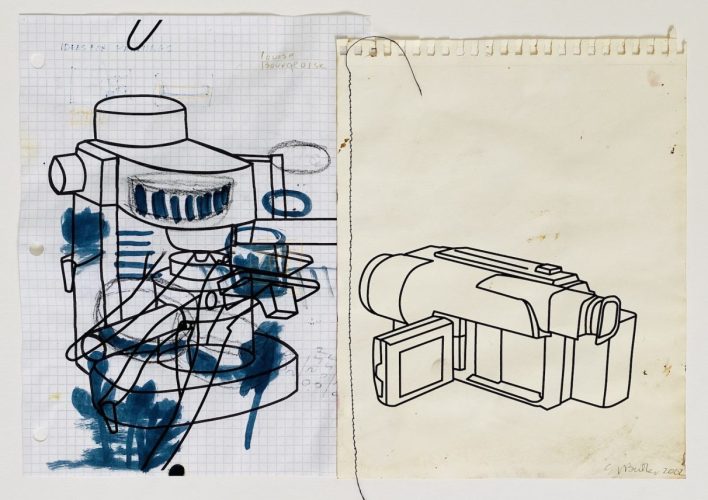
Louise Bourgeois, 2002
Acrylic, pen, pencil, inkjet print, sewing, collages on paper
11 x 17 in.

Caffeinated, 2002
Inkjet print, sewing, collages on paper
12 x 18 in.
PITCHES & SCRIPTS
January 20 – March 11, 2023
Jennifer Baahng Gallery is pleased to present PITCHES & SCRIPTS, a group exhibition of works on paper. On view are ink and graphite drawings, collages, inkjet prints and sewed surfaces produced from the 1980’s through 2020. In pooling together six artists, the exhibition pitches a fermentation of ideas, technologies, and political stances that connote rupture and disintegration, while scripting growth, movement and new life. PITCHES & SCRIPTS runs from January 20 through March 11, 2023, with its opening reception on Friday, January 20, 6 – 8 PM.
The spectral presence of history suffuses the work of Janet Taylor Pickett and Zhang Hongtu. Blackness is a “declarative statement” for Janet Taylor Pickett (b. 1948), whose works, as ongoing visual poems, probe personal and collective memory. Dresses Akimbo, on view, elaborates upon the symbolism of that gesture: a stance of power, bewilderment, and love. A forerunner of Chinese Political Pop Art whose work engages a multilayered discourse, Zhang Hongtu (b. 1943) asserts themes of dislocation, national identity, propaganda, and politics in the Long Live Mao series, which is equal parts whimsical and profound.
Idiomerica by Sharon Butler (b. 1959) was catalyzed by the artist’s move from New York City to the suburbs. The works investigate the visual grammar of capitalist suburban Americana through video animations, text projects, digital drawings, and the resulting tendencies of reductive art. Conversely, moving from the Midwest to New York City, Jeff Gabel (b. 1968) developed Short Fiction Sketches in scribbly and smudge tone drawings. The works externalize the imagination of a solitary artist inducted into a sea of uncanny urban experiences.
The Terminal Century by R.C. Baker (b. 1960) seethes with existential angst, as painted and collaged elements tremor with disruption and discordance, while also pointing to the beauty nestled in such moments of ostensive entropy. Similarly responding to a post-War world order, Bjorn Meyer-Ebrecht (b. 1972), makes ink drawings at a monumental scale, creating a pictorial architecture in ink that displays luminous materiality. In their rich, textured surfaces, the works included push the pictorial plane from drawing into painting.
PITCHES & SCRIPTS assembles the memories of the artists at a formative historical moment, and inquires how art shapes history by responding to cultural shifts or by instigating them itself. As we are flung—‘pitched’—into the future, the exhibition looks to this collection of work for a loose, dynamic script for how to narrativize ourselves in the present. PITCHES & SCRIPTS renders a ‘soft landing’ for our launch into the new year.
Related:

The Brooklyn Rail reviews RC Baker’s solo exhibition, “…and Nixon’s coming” the draft
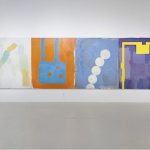
Adam Simon reviews Sharon Butler’s “Next Moves” in the October 2022 issue of The Brooklyn Rail

Janet Taylor Pickett is included in Century: 100 Years of Black Art at MAM
Categories: exhibitions
Tags: Björn Meyer-Ebrecht Janet Taylor Pickett Jeff Gabel RC Baker Sharon Butler Zhang Hongtu
GARDEN OF DELIGHT
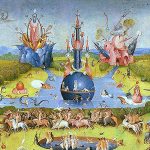





GARDEN OF DELIGHT
December 3 – 23, 2022
Opening Reception: Saturday, December 3, 10AM – 5PM
Packed with a sumptuous cornucopia of oil paintings, pastel drawings, ceramics, hand-painted books and moving sculptures, Garden of Delight is a festive and fantastical tableaux of visual delectables. A trove of glittering and luminous surfaces, ranging from the pocket-sized to the formidable, the exhibition offers treasures both tiny and substantial. Guests will be greeted by soldered compact discs, miniature paintings and a gold-plated lollipop on velvet plush. Like an advent calendar, pastel drawings by Michael McClard, collaged boxes by Janet Taylor Pickett and The Taillight Series by Sharon Butler are installed as a seasonal dense-hang. Wall-papered with Zhang Hongtu’s iPad drawings and Eric Brown’s woven paintings, the installation entices and beguiles. Meanwhile, a painted snowboard soars across the white wall, kicking up “flying art”—hand-painted fans by Jackie Matisse, conjuring snow. A deck of baseball card-sized portraits by Jeff Gabel depicts fictive strangers that breathe with a gentle gravity, and Lego-constructed handbags by Jaye Moon deliver Braille messages ranging from the cheeky “Text Me,” to the profound.
BAAHNG SHOP, the online shop of JENNIFER BAAHNG, offers a curated selection of books, exhibition catalogues, unique objects, limited editions, and artist designed accessories.
Related:
Categories: exhibitions
Tags: Museo del Prado
NEXT MOVES







Stacked 2, (July 16 and 17, 2019), 2022
Oil on linen
72 x 48 inches

Bedfrence (July 6, 2019), 2022
Oil on canvas
77 x 49 inches

Brighter than Grass (July 15, 2019), 2022
Oil on linen
78 x 60 inches

Addenda (February 10, 2019), 2022
Oil on linen
68 x 40 inches

Quasi-Believer (June 8, 2018), 2022
Oil on linen
68 x 24 inches
SHARON BUTLER
Next Moves
September 15 – November 15, 2022
Opening and Artist’s Reception: Thursday, September 15th, 6-8PM
JENNIFER BAAHNG GALLERY is pleased to present NEXT MOVES, the gallery’s inaugural solo exhibition of Sharon Butler’s work, and to announce its representation of the artist. The exhibition showcases a group of recent multi-panel paintings and selected mixed-media drawings. As conferred, these works articulate the pulse and the trajectory of Butler’s work, transposing graphic differences and traversing dimensions with elegance and wit. NEXT MOVES runs from September 15 through October 22, with an artist’s reception at the gallery on Thursday, September 15th, from 6–8PM.
In 2016, Sharon Butler began making digital drawings on a phone app called PicsArt. They were meant to be seen on a smartphone, and she posted one each morning on Instagram as a way of marking daily life. Over the course of four years, she made and posted more than 1200 of them. It was a “growing thinking” and a “time in an alley waiting it out.” Eventually, the impulse to paint – born of the irresoluteness that courses through all painters – took hold. In 2020, to facilitate the transformation of the tiny digital drawings into full-sized paintings, she began drawing geometric grids on canvases. The digital drawings encapsulated in small squares on the mobile screen, infinitely scalable and potentially endless, were transfigured into permanent building blocks.
In Butler’s work, the grid functions metaphorically as a pulsating chord; a portal through which she gets from point A to point B. As such, it encapsulates activity, gathering meaning and power over time. So deployed, the grid builds on Butler’s interest in wabi-sabi and the provisional approach that she has called, in The Brooklyn Rail and elsewhere, “casualism.” Like Piet Mondrian’s valedictory Broadway Boogie Woogie, her paintings apprehend the syncopation and movement of New York City, exploring seriality with conceptual rigor, opting for a serendipitous, ironic approach.
The multi-panel paintings in the exhibition are monumental versions of smaller solo works. They embrace the history of painting and abstraction by way of idiosyncratic conjunctions and addenda. They resound with color, texture, and light, while also establishing compositional formality, tactile physicality, and emotional resonance. These liberal re-imaginings of images that were once originally pixelated retain an expressively vibrational quality. At the same time, an exuberant materiality anchors convergent edges, shapes, and patterns that afford the work visual stability.
In artcritical, critic Laurie Fendrich described Butler’s paintings as “beautiful and grittily compelling.” Fendrich added that “the future of abstraction will be owned by those who accept a post-compositional approach to their paintings. Right now, Sharon Butler has the best of both worlds.” In NEXT MOVES, Sharon Butler proposes restlessness within the strictures of painting, courting risk and glory, and we are in her church.
Sharon Butler’s solo exhibitions have been reviewed in numerous publications, including New York Magazine, Hyperallergic, artcritical, The New Criterion, The James Kalm Report, and Time Out New York. She has been awarded grants from Creative Capital/Andy Warhol Foundation, the Pollock Krasner Foundation, the Connecticut Commission on the Arts, and Eastern Connecticut State University. She has held residencies at Yaddo, Blue Mountain Center, Pocket Utopia, and Counterproof Press. She has served as a visiting professor, artist, and/or critic at Brown University, Cornell University, the Hoffberger School of Painting (MICA), Penn State, the Pennsylvania Academy of the Fine Arts, the School of the Art Institute of Chicago, the School of Visual Arts, the Parsons School of Design at the New School, and the Vermont Studio Center. She is the founder of the art blogazine, Two Coats of Paint. She currently teaches in the MFA programs at the New York Academy of Art and the University of Connecticut.
Sharon Butler lives and works in New York.
Related:

Adam Simon reviews Sharon Butler’s “Next Moves” in the October 2022 issue of The Brooklyn Rail
Categories: exhibitions
Tags: Sharon Butler
TANGO



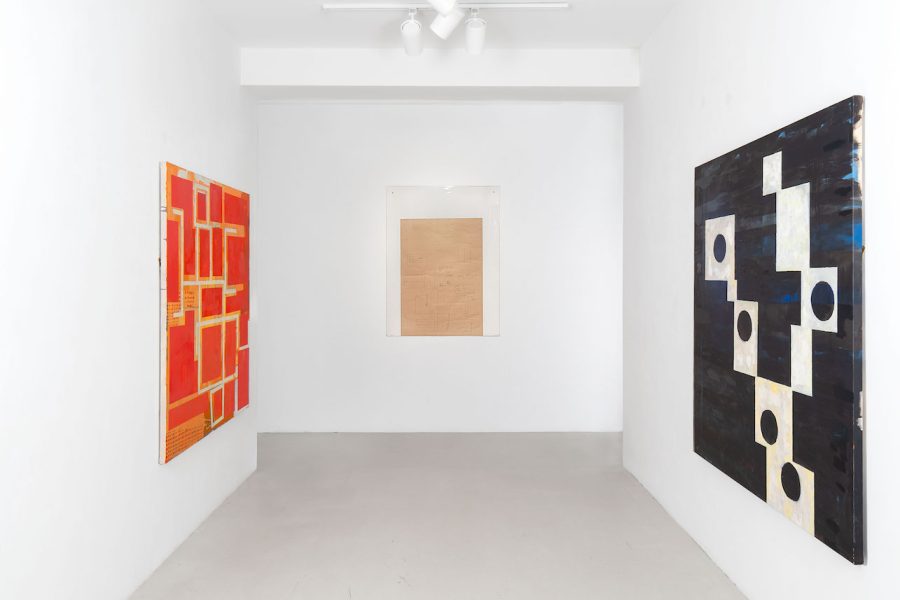




Self-Portrait in the Style of the Old Masters, 2001
Computer morphed Photograph digitally print with the artist frame
38 x 29 inches
Edition of 3

Follow The Light, 2013
Collage and acrylic on wood
6 x 6 x 2.5 inches

Journey Into The Interior, 2013-14
Collage and acrylic on canvas
12 x 16 x 1.5 inches

Just PassingThrough: Girlfriend, 2022
Pastel on paper
24 x 18 inches

Just PassingThrough: Boyfriend, 2022
Pastel on paper
24 x 18 inches

December 20, 2018, 2021
Oil on canvas
52 x 45 inches

San Miguel, 2021,
Oil on canvas
52 x 45 inches

Get That Money, 2022
Lego bricks and acrylic board
60 x 60 inches
TANGO
Summer Exhibition
July 13 - August 17, 2022
Related:

Adam Simon reviews Sharon Butler’s “Next Moves” in the October 2022 issue of The Brooklyn Rail

Jaye Moon is included in the New York Foundation for the Arts exhibition

Janet Taylor Pickett is included in Century: 100 Years of Black Art at MAM
Categories: exhibitions
Tags: Chun Kwang Young David Sallie Janet Taylor Pickett Jaye Moon Jeff Gabel Mario Merz Michael Mcclard MR. Osvaldo Romberg Romare Bearden Sharon Butler Zhang Hongtu



































